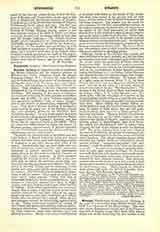

Kutenai Indians, an important tribe of southeastern British Columbia and the adjacent portions of Montana and Idaho, occupying chiefly the present Kootenay County, B.C., between the main Rockies and the Selkirk Range, from about 52° southwards, including the basins of the Kootenay and Lower Columbia rivers, and extending to Lake Pend d’Oreille in Idaho. They constitute a distinct linguistic stock, designated as the Kitunahan, from the proper name, Kitonaga. The meaning of this name is unknown, but it occurs in the form of Cattanahowes on the Mackenzie map of 1801. To their Salishan neighbors they are known as Skalzi, “lake, or water, people”, and to the French as Arcs-A-plats, anglicized Flat-bows. They have a distinct tradition of having formerly lived in the plains east of the Rockies, whence they were probably driven by the Blackfeet, their hereditary enemies. Up to a recent period they were in the habit of making annual descents into the Plains, in company with the Flatheads, Kalispel, and Nez Perces, for the purpose of hunting the buffalo. They are commonly differentiated as Upper and Lower (or Flatbow proper), approximately in British Columbia and the United States respectively, with several minor subdivisions and two main dialects.
Physically the Kutenai rank as the tallest and best built Indians of British Columbia, being also almost entirely free from blood taint and other consequences of dissipation so prevalent among other tribes of the region. Intellectually they are more stable and capable of continuous mental exertion, while concurrent testimony of traders, travellers, and missionaries places them in the first rank for morality, honesty, reliability, and manly qualities. In their primitive condition the Kutenai lived in small skin or mat-covered tipis, of which the universal sweat lodge (see Indians) was always an important adjunct. They subsisted by hunting, fishing, and the gathering of wild berries and roots, particularly camas (Camassia: see Kalispel Indians). The Lower Kutenai dried immense quantities of fish for winter. They made no pottery, but were expert basket weavers, boiling their food in watertight baskets by means of heated stones. They dressed in buckskin, painted their faces in bright colors, and wore their hair full length, either braided or flowing. Their social organization was extremely simple, with no trace of the clan system or the secret societies common to most other tribes of the region. Each band had its own chief, hereditary in a certain family, who was assisted by a council. Both slavery and polygamy existed, the slaves being captives taken in war. Erring wives were punished by cutting off one of their hair braids, instead of by death or mutilation as in other tribes. Orphan children were adopted by their relatives, while near relatives were not allowed to marry. Murder was compounded by a fine or punished with death by the family of the victim. The dead were buried in the ground with all their finery and the debts of the deceased were paid by the surviving relatives. The religion was the usual Indian Animism, with the Sun, personified as a woman, as the highest and most beneficent deity, to whose home the spirits of the dead journeyed, to rejoin their friends later in this world at a place of sacred pilgrimage on the shore of Lake Pend d’Oreille. Tabus, fasting, and sacrifice were a part of the system, and the shaman doctors exercised great influence. Among their great ceremonies was the fish festival, described by De Smet as witnessed by him in 1845. The Lower Kutenai, who retained more of their primitive custom, are still much addicted to gambling games.
Although known to the Hudson Bay traders and other adventurers as early, perhaps, as 1780, the Kutenai remained practically unchanged until the advent of the Jesuits under the leadership of Father Peter De Smet, about 1840. In the next two years he preached to visiting bands of the tribe at the Flathead mission, and, on the establishment of Saint Ignatius mission among the Kalispel Indians (q.v.) by Fathers Adrian Hoecken and Antonio Ravalli, the southern bands were brought regularly under mission influence. In August, 1845, at a large camp on Kutenai River, U.S., De Smet himself celebrated “the first Maas ever offered in their land” and set up the cross of a mission, which he named in honor of the day “The Assumption“. The mission of the Sacred Heart of Mary was founded on the Tobacco Plains, B.C., within the next year. The whole tribe, with the exception of a portion of the Lower Kutenai, accepted almost at once the new faith, in which they have remained steadfast and exemplary ever since. Those within the United States are chiefly gathered upon the Flathead reservation, Montana, by treaty of 1855; where they are still under Jesuit teaching, while some few in Idaho probably retain their old beliefs. Those in British Columbia are under the ministry of the Oblate Fathers, who, assisted by the Sisters of Charity, conduct a successful mission school at Saint-Eugene, near Fort Steele. The school was established in 1874 by Father Leon Fouquet, the first of the Oblates to enter the Kutenai field. The great majority have long since adopted the ways of civilization, and subsist by farming, stock-raising, and laboring in the lumber camps and for the white ranchers. The official Canadian report (1908) describes the various bands as “industrious, steady and law abiding”, “temperate and moral”, and “progressing”, while the mission work “deserves the greatest praise”. In spite of several great epidemic visitations in years past, notably smallpox, the Kutenai have held their own well, thanks to their innate manliness and to their strict observance of the precepts inculcated by their religious teachers. They probably number now nearly as many as at any period in their history and even seem to have largely increased within the past twenty years. Official reports for 1908 give them about 1120 souls, viz: British Columbia, Kootenay Agency, 513; Montana Agency, 606.
JAMES MOONEY

